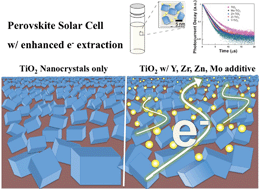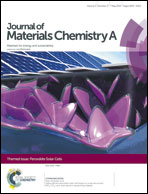Improving the TiO2 electron transport layer in perovskite solar cells using acetylacetonate-based additives†
Abstract
We developed a facile and quantitative method to improve the electron transport properties and resulting device performances of perovskite solar cells based on post-incorporation of various acetylacetonate additives. Previous studies rely on synthesis or soaking processes with limited additive control. Here, our acetylacetonated-based additives are used as effective intermediate gels to interact with TiO2 nanocrystals using a simple approach. The incorporation process can be controlled effectively and quantitatively using a range of additives from divalent (II), trivalent (III), and tetravalent (IV) to hexavalent (VI) acetylacetonate. Electronic parameters of solar cell devices, such as short circuit current (Jsc) and fill factor (FF), are enhanced, regardless of the different valencies of the additives. Zirconium(IV) acetylacetonate was found to be the most effective additive, with average PCE improved from 15.0% to 15.8%. Detailed characterization experiments including transient photoluminescence spectra, ultra-violet photoelectron spectroscopy, photovoltage decay, and photocurrent decay indicate an improved interface with improved carrier extraction originating from the TiO2 modification.

- This article is part of the themed collection: Perovskite Solar Cells

 Please wait while we load your content...
Please wait while we load your content...